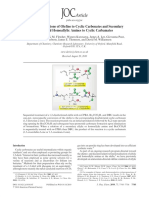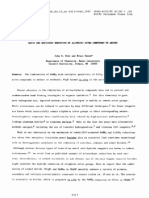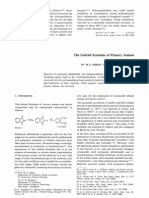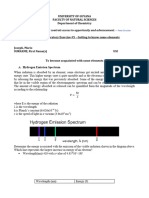Leuckart Reaction
Leuckart Reaction
Uploaded by
KybernetikumCopyright:
Available Formats
Leuckart Reaction
Leuckart Reaction
Uploaded by
KybernetikumOriginal Title
Copyright
Available Formats
Share this document
Did you find this document useful?
Is this content inappropriate?
Copyright:
Available Formats
Leuckart Reaction
Leuckart Reaction
Uploaded by
KybernetikumCopyright:
Available Formats
Catalytic Leuckart-Wallach-Type Reductive Amination of Ketones
Masato Kitamura,* Donghyun Lee, Shinnosuke Hayashi, Shinji Tanaka, and Masahiro Yoshimura
Research Center for Materials Science and the Department of Chemistry, Nagoya University, Chikusa, Nagoya 464-8602, Japan
Received June 3, 2002
Abstract: A Cp*Rh(III) complex catalyzes reductive amination of ketones using HCOONH4 at 50-70 C to give the corresponding primary amines in high yields. The reaction is clean and operationally simple and proceeds at a lower temperature and with higher chemoselectivity than the original Leuckart-Wallach reaction. The new method has been applied to the synthesis of R-amino acids directly from R-keto acids.
FIGURE 1. The reactivity and selectivity profiles of the 8, 9,
and 10 group metal complexes in the catalytic LW reaction using acetophenone and ammonium formate: dark shading, 1-phenylethylamine (2a); lighter shading, di(1-phenylethyl)amine (3a); white, N-formyl-1-phenylethylamine (4a); striped, 1-phenylethanol (5a); light shading, others.
Reductive amination of carbonyl compounds is attractive in organic synthesis because ketones or aldehydes can be transformed, in one reaction vessel, directly to the corresponding secondary or primary alkylamines without isolation of the intermediary imines or hydroxy amines.1 The reaction with formic acid as a reducing agent is called the Leuckart-Wallach (LW) reaction.2 The LW reaction is very simple and clean, but it suffers from several drawbacks such as the requirement of high temperature (mostly above 180 C), the formation of N-formyl derivative, and the difficulty of the selective synthesis of primary amine from ammonia.3 Such a reaction is in general most useful and efficient when performed catalytically, rather than stoichiometrically, but during the past 100 years, only a few reports on the catalytic version of LW reaction have been made.4 This is apparently because the reported methods using Raney Ni or Co could not overcome the above deficiencies. In this paper, we describe a new and efficient catalytic LWtype reductive amination of ketones. The 8, 9, and 10 group metal complexes having Cp*, Cp, COD, or P(C6H5)3 ligand were selected because most of these complexes are able to hydrogenate the unsaturated organic molecules.5 The catalytic activity for the LW reaction was screened by use of 3-5 mmol of acetophe(1) Reviews: (a) March, J. In Advanced Organic Chemistry; WileyInterscience: New York, 1992; pp 898-900. (b) Trost, B. M.; Verhoeven, T. R. In Comprehensive Organometallic Chemistry; Wilkinson, G., Stone, F. G. A., Abel, E. W., Eds.; Pergamon: Oxford, 1982; Vol. 8, p 84. (c) Buehler, C. A.; Pearson, D. E. In Survey of Organic Syntheses; Wiley-Interscience: New York, 1970; pp 427-429. (d) Wheeler, O. H. In The Chemistry of the Carbonyl Group; Patai, S., Ed.; Interscience: New York, 1966; pp 529-532. (e) Werner, J. Ind. Eng. Chem. 1961, 53, 77-78. (2) (a) Leuckart, R. Ber. Dtsch. Chem. Ges. 1885, 18, 2341-2344. (b) Wallach, O. Ber. Dtsch. Chem. Ges. 1891, 24, 3992. (3) (a) Moore, M. L. Org. React. 1949, 5, 301-330. (b) Gibson, H. W. Chem. Rev. 1969, 69, 673-692. (4) (a) Komarov, V.; Chernikova, E. A.; Komarov, G. V. Zh. Fiz. Khim. 1962, 36, 540-545; Chem. Abstr. 1962, 57, 1605. (b) Kost, A. N. Nauchn. Dokl. Vysshei. Shk. Khim. Khim. Tekhnol. 1958, 125-129. (c) Mousseron, M.; Jacquier, R.; Zagdoun, R. Bull. Soc. Chim. Fr. 1953, 974-981.
10.1021/jo0203701 CCC: $22.00 2002 American Chemical Society
none (1a) and ammonium formate by fixing the concentrations of the complex, 1a, and ammonium formate, temperature, reaction time, and solvent to 5 mM, 1 M, 5 M, 70 C, 2 h, and methanol, respectively. The yields of the possible products, 1-phenylethylamine (2a), di(1phenylethyl)amine (3a), N-formyl-1-phenylethylamine (4a), and 1-phenylethanol (5a), were determined by 1H NMR analysis ( 2.62 (s, CH3 of 1a), 4.18 (q, J ) 6.6 Hz, CH of 2a), 3.59 (q, J ) 6.6 Hz, CH of meso-3a), 3.86 (q, J ) 7.4 Hz, CH of dl-3a), 4.69 (dq, J ) 7.4, 7.4 Hz, CH of the minor rotamer of 4a), 5.22 (dq, J ) 7.3, 7.3 Hz, CH of the major rotamer of 4a), 4.90 (q, J ) 6.6 Hz, CH of 5a)).
Figure 1 illustrates the reactivity and selectivity of the complexes investigated. [RhCp*Cl2]2 (6)6 shows the highest efficiency among others. Under the standard conditions, 98% of acetophenone is converted to 2a, 3a, 4a, and 5a in a 96.5:0.5:1.0:2.0 ratio. The desired product 2a can be isolated in pure form in 90% yield by a simple partition between organic and aqueous layers. [Ir(cod)Cl]27 also catalyzes the LW reaction to give a 96:0:1:2 mixture of 2a, 3a, 4a, and 5a, although the reactivity is lowered. Table 1 lists the results of the optimization of the conditions using [RhCp*Cl2]2. The complete consump(5) Review: Harmon, R. E.; Gupta, S. K.; Brown, D. J. Chem. Rev. 1973, 73, 21-52. (6) Kang, J. W.; Moseley, K.; Maitlis, P. M. J. Am. Chem. Soc. 1969, 91, 5970-5977.
Published on Web 11/05/2002
J. Org. Chem. 2002, 67, 8685-8687
8685
TABLE 1. [RhCp*Cl2]2-Catalyzed Reductive Amination of Simple Ketonesa
concentrations (M) entry substrate 1 2 3e 4 5f 6 7 8 9 10 11f 12f 13f 14 15 16 17 18 19 20 21 22 23 24 25 26 27 28 29 30 1a (1) 1a (1) 1a (1) 1a (1) 1a (1) 1a (1) 1a (1) 1a (0.5) 1a (0.33) 1a (5) 1a (1) 1a (1) 1a (1) 1a (1) 1a (1) 1a (1) 1a (1) 1a (1) 1a (1) 1a (1) 1a (1) 1a (1) 1a (1) 1a (1) 1b (1) 1c (1) 1d (1) 1e (1) 1f (1) 1g (1) hydride and amine source HCOONH4 (5) catalyst CH3OH CH3OH CH3OH CH3OH CH3OH CH3OH CH3OH CH3OH CH3OH CH3OH 30:1 CH3OH-H2O 1:1 CH3OH-CF3CH2OH 1:1 i-C3H7OH-CF3CH2OH i-C3H7OH CH3CN DMF CH2Cl2 THF C6H6 c-C6H12 CH3OH CH3OH CH3OH CH3OH CH3OH CH3OH CH3OH CH3OH CH3OH CH3OH solvent time, h % convn 2 6 5 31 6 6 6 1 6 2 6 6 6 2 2 2 2 2 2 2 2 2 1 1 3 5 30 9 11 2 98 >99 98 >99 85 95 54 >99 89 78 64 80 71 41 3 13 14 13 8 3 50 93 63 65 >99 >99 43 47 11 >99 2 96.5 d 90 95.5 55.7 89.8 85 43 95.2 94.5 85.8 93.7 88.4 78.7 85 0 96.3 0 65.8 0 0 83.3 91 97.6 94.6 98.9 95.0 71.9 61.9 80.8 product ratiob,c 3 4 5 0.5 1.0 2.0 2.0 2.4 1.4 3.6 9.5 30.6 2.3 4.0 7.6 4.2 6.3 13.4 10.5 >99 3.7 >99 34.2 >99 >99 5.5 4.9 1.2 2.2 0.6 4.0 0.7 35.3 5.1 others 0 0 0 8.9 4.4 0 24.4 0.3 0 2.5 0 0 0 0 <1 0 <1 0 <1 <1 4.6 0 1.2 3.2 0 0 0 0 0
[Cp*RhCl2]2 (6) (0.005) HCOONH4 (5) 6 (0.005) HCOONH4 (5) 6 (0.005) HCOONH4 (5) 6 (0.005) HCOONH4 (5) 6 (0.005) HCOONH4 (2) 6 (0.005) HCOONH4 (1) 6 (0.005) HCOONH4 (5) 6 (0.0025) HCOONH4 (1.65) 6 (0.00165) HCOONH4 (25) 6 (0.025) HCOONH4 (5) 6 (0.005) HCOONH4 (5) 6 (0.005) HCOONH4 (5) 6 (0.005) HCOONH4 (5) 6 (0.005) HCOONH4 (5) 6 (0.005) HCOONH4 (5) 6 (0.005) HCOONH4 (5) 6 (0.005) HCOONH4 (5) 6 (0.005) HCOONH4 (5) 6 (0.005) HCOONH4 (5) 6 (0.005) HCOOH (5)NH3 6 (0.005) (ca. 7) HCOOH (7)NH3 6 (0.005) (ca. 5) HCOONH4 (5) [Cp*RhI2]2 (0.005) HCOONH4 (5) [Rh2Cp*2Cl3]BARF (0.005) HCOONH4 (5) 6 (0.005) HCOONH4 (5) 6 (0.005) HCOONH4 (5) 6 (0.005) HCOONH4 (5) 6 (0.005) HCOONH4 (5) 6 (0.005) HCOONH4 (5) 6 (0.005)
1.0 7.0 0.8 1.3 0 34 2.2 0 4.5 1.0 2.0 0 2.2 0 0.5 1.0 4.1 0 1.1 1.0 5.3 0 6.6 1.3 4.5 0 0 0 0 0 0 0 0 0 0 0 0 0 4.0 2.6 0.8 0 0 3.3 0 0
0 0.5 0 1.0 0 27.4 0 2.8 14.1 0
a Reactions were carried out at 70 C under an argon atmosphere unless otherwise specified. b The product ratio was determined by 500 MHz 1H NMR analysis. For details, see the Supporting Information. c The value 0 denotes that the signals are not detected by the 1H NMR analysis of the crude reaction mixture. d 90% isolated yield. e Reaction was carried out without any special care about moisture and air. f 50 C.
tion of 1a takes 6 h, while the N-formyl compound 4a is formed in 7% yield (entry 2). Without any special care about moisture and air, 98% of acetophenone is converted to 2a, 3a, 4a, and 5a in a 95.5:0.8:1.3:2.4 ratio (entry 3). The amount of 4a is increased to 34% after 31 h (entry 4). At 50 C, both the reactivity and selectivity is dramatically decreased due to the low solubility of HCOONH4 in methanol (entry 5). A 5 mol amount of HCOONH4 is essential. Lowering the concentration to 2 M, the 2a/5a ratio is decreased to 9 (entry 6). With 1 M HCOONH4, the reactivity is halved and the alcohol product 5a is produced in >50% yield (entry 7). A 10 mol amount of HCOONH4 results in completed reaction with high chemoselectivity after 1 h (entry 8). The total concentration can be reduced to 0.33 M without loss of the amine/alcohol selectivity (entry 9), but an increase to 5 M results in the insolubility of HCOONH4 (entry 10). Methanol is the solvent of choice. The reactivity is decreased in aqueous methanol, 1:1 alcohol-CF3CH2OH, and 2-propanol (entries 11-14). In aprotic solvents, the yields of the reduction products never exceed 15% (entries 15-20). In CH3CN, CH2Cl2, benzene, and cyclohexane, the alcohol 5a was obtained selectively (entries 15, 17, 19, and 20). On the other hand, the LW product 2a was predominantly produced in DMF and THF (entries 16
8686 J. Org. Chem., Vol. 67, No. 24, 2002
and 18). Use of an excess either of ammonia or formic acid decreases the reactivity (entries 21 and 22). [RhCp*I2]26 and [Rh2Cp*2Cl3]BARF8 also showed the same reactivity and selectivity as those of [RhCp*Cl2]2 (entries 23 and 24). The reproducibility was confirmed on a 10 g scale reaction using 1a. Thus, a 1:5 mixture of 1a and HCOONH4 was reacted in methanol (83 mL) containing 257 mg of [RhCp*Cl2]2 at 70 C for 7 h, giving 2a in 92% yield as determined by NMR analysis of the crude mixture obtained by a usual workup under basic condition.9 The pure 2a was isolated in 85% yield (see the Experimental Section). The generality is high. All of primary, secondary alkyl methyl ketones (1b and 1c) studied can be converted to the corresponding primary amines in greater than 90% yield (entries 25 and 26). The cyclic ketone (1g) remains a high reactivity, but the 2g/3g ratio is decreased to 6 (entry 30). The reactivities of pinacolone (1d) and diphenyl ketone (1e) are low, and with dicyclohexyl ketone (1f) no reaction at all occurred.
(7) Winkhaus, G.; Singer, H. Chem. Ber. 1966, 99, 3610-3618. (8) BARF ) tetrakis(3,5-bis(trifluoromethyl)phenyl)borate. Preparation of [Rh2Cp*2Cl3]B(C6H5)4: Kang, J. W.; Maitlis, P. M. J. Organomet. Chem. 1971, 30, 127-133. (9) For details of the workup, see the Supporting Information.
TABLE 2. [RhCp*Cl2]2-Catalyzed Reductive Amination
of r-Keto Acidsa
a Conditions: [substrate] ) 1 M, [6] ) 5 mM, [HCOONH ] ) 5 4 M, CH3OH, 50 C, 2 h. b The yields were determined by 1H NMR analysis using mesitylene as an internal standard. The values in parentheses correspond to the isolated yields. c 1.5 h. d 75 h.
As shown in Table 2, the present catalytic LW-type reaction can be applied to the R-keto acids.10 When benzoylformic acid (7) was subjected to the above established conditions ([6] ) 5 mM, [7] ) 1 M, [HCOONH4] ) 5 M, CH3OH, 50 C), the reductive amination product was precipitated from the reaction mixture. Filtration gives pure phenylglycine in 81% isolated yield. Other keto acids possessing indole and thiophene groups (8 and 9) were also converted to the corresponding amino acids in good isolated yields. These amino acids cannot be synthesized via enzymatic methods.11 tert-Butylglycine was obtained in 70% yield by use of 3,3-dimethyl-2-oxobutanoic acid (10). 3-(2-Furanyl)-2-oxoethanoic acid and pyruvic acid possessing R proton did not work under the present conditions. When the Rh(III) complex 6 is mixed with a 37 mol amount of HCOONH4 in CD3OH, the 1H NMR signals appear at -8.7 (t, J ) 27.5 Hz) and -9.4 (t, J ) 26.0 Hz) after 20 min at room temperature. These converge, after 2 h at 70 C, to the signals at -18.4 (dd, J ) 26.0 Hz) and -18.5 (dd, J ) 26.0 Hz). These hydride species can be assigned to hydride-bridged dinuclear Rh complexes,12 which would be just kinetic repositories for the real catalytic species.13 We assume that [RhCp*Cl2]2 is converted, by the action of NH3 and HCOOH, into an ammonia-coordinated metal hydride RhCp*HCl(NH 3)
(10) Adger, B. M.; Dyer, U. C.; Lenmon, I. C.; Tiffin, P. D.; Ward, S. E. Tetrahedron Lett. 1997, 38, 2153-2154. (11) Williams, R. M. In Synthesis of Optically Active R-Amino Acids; Pergamon: New York, 1989; Chapter 7. (12) White, C.; Oliver, A. J.; Maitlis, P. M. J. Chem. Soc., Dalton Trans. 1973, 1901-1907. (13) (a) Kitamura, M.; Tsukamoto, M.; Bessho, Y.; Yoshimura, M.; Kobs, U.; Widhalm, M.; Noyori, R. J. Am. Chem. Soc. 2002, 124, 66496667. (b) Noyori, R.; Kitamura, M. Angew. Chem., Int. Ed. Engl. 1991, 30, 49-69.
that acts as a chain carrier in the catalytic cycle.14 Coordination of NH3 onto Rh enhances the acidity of the hydrogen atom of NH3 and also the nucleophilicity of the hydride of RhH.13,15 The synergetic effect facilitates the formation of a catalyst-imine complex and then stabilizes the transition state by realizing the charge alternation on the CdNH-N-Rh-H six atoms.13 The hydride transfer from RhH to the CdN carbon gives a catalystproduct complex, which releases a free amine product together with the formation of a metal amide species. The Rh-NH2 reacts quickly with formic acid to generate CO2 and RhCp*HCl(NH3), completing the catalytic cycle. In summary, a novel catalytic system facilitating the Leuckart-Wallach-type reaction at a lower temperature with high chemoselectivity and generality has been established. Other than the desired primary amine products, the reaction produces only CO2 and H2O. Using 0.005 mol amount of catalyst and HCOONH4, a variety of substrates including simple ketones are converted to the corresponding primary amines. With R-keto acids, R-amino acids are the products. The reaction is clean and operationally simple. In most cases, only filtration is necessary to arrive at R-amino acids in high yields. Related studies on the asymmetric synthesis as well as the mechanism are being carried out. These results will be reported in due course. Experimental Section
Ten-Gram-Scale Procedure. Acetophenone (9.71 mL, 83.2 mmol) and CH3OH (83.2 mL) were added to a 1000 mL Schlenk tube containing [RhCp*Cl2]2 (6) (257 mg, 416 mol) and HCOONH4 (26.2 g, 416 mmol). The reddish brown mixture was frozen, and the whole system was evacuated. The system was closed and then stirred at 70 C for 7 h. After the dark green resulting solution was cooled to room temperature, 1 M aqueous HCl solution (160 mL) was added, and the mixture was washed twice with CH2Cl2 (20 mL) to remove the neutral compounds. After addition of a cold 12 M aqueous NaOH solution (15 mL) to the aqueous layer, the mixture was extracted six times with CH2Cl2 (50 mL). The combined organic layers were dried over anhydrous Na2SO4. Filtration and evaporation under reduced pressure gave crude 2a (9.3 g, 92%) in >99% purity determined by 1H NMR and GC analyses (for details, see the Supporting Information). This was distilled at 83 C/44 mmHg to give 2a (8.6 g, 85% yield).
Acknowledgment. This work was aided by the Grant-in-Aid for Scientific Research (No. 07CE2004) from the Ministry of Education, Science, Sports and Culture, Japan. We are grateful to Professor R. Noyori for valuable discussions and financial support. We thank Mr. T. Noda for making the reaction vessels.
Supporting Information Available: General procedures for screening and the reductive amination of R-keto acids and characterization of all substrates and products obtained by the present method. This material is available free of charge via the Internet at http://pubs.acs.org. JO0203701
(14) Mao, J.; Baker, D. C. Org. Lett. 1999, 1, 841-843. (15) Noyori, R.; Ohkuma, T. Angew. Chem., Int. Ed. 2001, 40, 4073.
J. Org. Chem, Vol. 67, No. 24, 2002 8687
You might also like
- A Rapid, High-Yield Conversion of Codeine To MorphineDocument2 pagesA Rapid, High-Yield Conversion of Codeine To Morphinegeovani250% (2)
- BS For Chemicals To Water TreatmentDocument18 pagesBS For Chemicals To Water TreatmentKalinda0% (1)
- Manual of Formulas - Recipes, Methods & Secret ProcessesFrom EverandManual of Formulas - Recipes, Methods & Secret ProcessesRating: 4.5 out of 5 stars4.5/5 (2)
- Demethylation With LiCl-DMF (JMolCatA-Chemical2007)Document8 pagesDemethylation With LiCl-DMF (JMolCatA-Chemical2007)Archawin_mooNo ratings yet
- 03 Protein StructureDocument5 pages03 Protein StructureIvan TranconNo ratings yet
- Microwave Assisted Chemistry Experiments: (Organic Synthesis, Chemical analysis and Extraction)From EverandMicrowave Assisted Chemistry Experiments: (Organic Synthesis, Chemical analysis and Extraction)No ratings yet
- Organic Syntheses / An Annual Publication of Satisfactory Methods for the Preparation of Organic ChemicalsFrom EverandOrganic Syntheses / An Annual Publication of Satisfactory Methods for the Preparation of Organic ChemicalsNo ratings yet
- Young's Demonstrative Translation of Scientific Secrets Or, A Collection of Above 500 Useful Receipts on a Variety of SubjectsFrom EverandYoung's Demonstrative Translation of Scientific Secrets Or, A Collection of Above 500 Useful Receipts on a Variety of SubjectsNo ratings yet
- Legal Chemistry: A Guide to the Detection of Poisons, Examination of Tea, Stains, Etc., as Applied to Chemical JurisprudenceFrom EverandLegal Chemistry: A Guide to the Detection of Poisons, Examination of Tea, Stains, Etc., as Applied to Chemical JurisprudenceNo ratings yet
- Chemistry at Home - A Collection of Experiments and Formulas for the Chemistry EnthusiastFrom EverandChemistry at Home - A Collection of Experiments and Formulas for the Chemistry EnthusiastNo ratings yet
- Workbook for Organic Synthesis: The Disconnection ApproachFrom EverandWorkbook for Organic Synthesis: The Disconnection ApproachRating: 4.5 out of 5 stars4.5/5 (2)
- Oxazoles: Synthesis, Reactions, and Spectroscopy, Part AFrom EverandOxazoles: Synthesis, Reactions, and Spectroscopy, Part ADavid C. PalmerNo ratings yet
- The Pyrotechnist's Treasury Or, Complete Art of Making FireworksFrom EverandThe Pyrotechnist's Treasury Or, Complete Art of Making FireworksNo ratings yet
- Organometallic Transition Metal Catalysis: A Holistic Approach to Understanding and Predicting their MechanismsFrom EverandOrganometallic Transition Metal Catalysis: A Holistic Approach to Understanding and Predicting their MechanismsNo ratings yet
- Nitro-Explosives: A Practical TreatiseFrom EverandNitro-Explosives: A Practical TreatiseRating: 2.5 out of 5 stars2.5/5 (3)
- GM - Synth Commun - Aza - 2008Document8 pagesGM - Synth Commun - Aza - 2008Rudraksha BhattacharyaNo ratings yet
- Sinteza Chimica AdamantanDocument4 pagesSinteza Chimica AdamantanclapadusNo ratings yet
- Synthesis and Regiochemistry of (60) Fullerenyl 2-Methylmalonate Bisadducts and Their Facile Electron-Accepting PropertiesDocument10 pagesSynthesis and Regiochemistry of (60) Fullerenyl 2-Methylmalonate Bisadducts and Their Facile Electron-Accepting PropertiesDiogo DiasNo ratings yet
- Enantioselective Intermolecular (2 + 2) - Photocycloaddition Reactions of Alkenes and A 2-Quinolone in SolutionDocument2 pagesEnantioselective Intermolecular (2 + 2) - Photocycloaddition Reactions of Alkenes and A 2-Quinolone in SolutionM PadilNo ratings yet
- Bio Org Chem Lett 2008Document4 pagesBio Org Chem Lett 2008Suman BalyaniNo ratings yet
- A Rapid High Yield Conversion of Codeine To MorphineDocument7 pagesA Rapid High Yield Conversion of Codeine To Morphinemehdighorbani2002No ratings yet
- MMC 1Document6 pagesMMC 1umesh123patilNo ratings yet
- Harzialactone TA 2005 LuDocument3 pagesHarzialactone TA 2005 LuhloicNo ratings yet
- Ja971400y Si 001Document14 pagesJa971400y Si 001mike van dorsselaerNo ratings yet
- Synthesis of Fused Quinazolinethiones and Their S-Alkyl/aryl DerivativesDocument9 pagesSynthesis of Fused Quinazolinethiones and Their S-Alkyl/aryl Derivativesthamizh555No ratings yet
- 2002 JOC - DMC AnilineDocument10 pages2002 JOC - DMC AnilinechemistryNo ratings yet
- Org Lett 2006 8 2699 - CannabinoidsDocument4 pagesOrg Lett 2006 8 2699 - CannabinoidsFatty BhuwaneeNo ratings yet
- Studies On Manganese (Ii) Catalyzed Oxidation of N-Methylaniline by Periodate IonDocument10 pagesStudies On Manganese (Ii) Catalyzed Oxidation of N-Methylaniline by Periodate IonYuda AryokoNo ratings yet
- Mechansm of Luche ReductionDocument6 pagesMechansm of Luche ReductionAnish RaoNo ratings yet
- Diazotazione NaNO2 NaHSO3Document3 pagesDiazotazione NaNO2 NaHSO3leda_prandiNo ratings yet
- Synthesis of Quinolizinium SaltsDocument3 pagesSynthesis of Quinolizinium Saltsspkgchem74670% (1)
- An Efficient Procedure For The Demethylation of Aryl-Methyl Ethers in Optically Pure Unusual Amino Acids PDFDocument4 pagesAn Efficient Procedure For The Demethylation of Aryl-Methyl Ethers in Optically Pure Unusual Amino Acids PDFFelipe MonteroNo ratings yet
- A General Method For The Quaternization of N, N-Dimethyl Benzylamines With Long Chain N-AlkylbromidesDocument4 pagesA General Method For The Quaternization of N, N-Dimethyl Benzylamines With Long Chain N-AlkylbromidesirfanNo ratings yet
- 7745 PDFDocument12 pages7745 PDFDiogomussumNo ratings yet
- Journal of Chemistry, 2020, 9248793Document9 pagesJournal of Chemistry, 2020, 9248793Leonela RojasNo ratings yet
- Molecules: New 3H-Indole Synthesis by Fischer's Method. Part IDocument8 pagesMolecules: New 3H-Indole Synthesis by Fischer's Method. Part ILEONETTILENCINANo ratings yet
- Copper-Boxmi Complexes As Highly Enantioselective Catalysts ForDocument5 pagesCopper-Boxmi Complexes As Highly Enantioselective Catalysts Forxuyijing2007comNo ratings yet
- Synthesis of Ketosulfides Based On Benzalacetone and Research Into Their Inhibitory PropertiesDocument7 pagesSynthesis of Ketosulfides Based On Benzalacetone and Research Into Their Inhibitory PropertiesakilanrameshNo ratings yet
- Chlorination of Alcohols by Pivaloyl Chloride-DMFDocument3 pagesChlorination of Alcohols by Pivaloyl Chloride-DMFalchymystNo ratings yet
- Total Synthesis of Echinopines A and BDocument4 pagesTotal Synthesis of Echinopines A and BmariameNo ratings yet
- Experimental Section: 1 The The To The andDocument3 pagesExperimental Section: 1 The The To The andPrashant SinghNo ratings yet
- 1 s2.0 S0020169305006274 Main PDFDocument5 pages1 s2.0 S0020169305006274 Main PDFhenry martinez quiñonezNo ratings yet
- The Derivatives of 3 - (1h-Benzimidazole-2) Propanoic Acid Synthesis and Analgetic and Anti Inflammatory Activity - Pakistan J Pharm Sci, 1989, 2 (1), 7-12Document6 pagesThe Derivatives of 3 - (1h-Benzimidazole-2) Propanoic Acid Synthesis and Analgetic and Anti Inflammatory Activity - Pakistan J Pharm Sci, 1989, 2 (1), 7-12muopioidreceptorNo ratings yet
- Modification of The Hofmann Rearrangement, Synthesis of Methyl CarbamatesDocument3 pagesModification of The Hofmann Rearrangement, Synthesis of Methyl CarbamatesIsmet KutlukNo ratings yet
- Preparation & Bio-Chemical Identification of Series Organic CompoundsDocument9 pagesPreparation & Bio-Chemical Identification of Series Organic CompoundschemistryjournalNo ratings yet
- Heterogeneous Asymmetric Diels-Alder Reactions Using A Copper-Chiral Bis (Oxazoline) Complex Immobilized On Mesoporous SilicaDocument5 pagesHeterogeneous Asymmetric Diels-Alder Reactions Using A Copper-Chiral Bis (Oxazoline) Complex Immobilized On Mesoporous SilicaJC Jane BarnesNo ratings yet
- A New Method For The Synthesis of Heterocycles FromDocument4 pagesA New Method For The Synthesis of Heterocycles FromPamelaaGaytanNo ratings yet
- Almajan L PDFDocument15 pagesAlmajan L PDFIonut DumistrascuNo ratings yet
- Trans Imminazione Beta ControllataDocument2 pagesTrans Imminazione Beta ControllatafuturichimiciNo ratings yet
- Gian Luca Araldi Et Al - An Enantioselective Synthesis of 2-Alkyl-3-Phenyltropanes by An Asymmetric 1,3-Dipolar Cycloaddition ReactionDocument2 pagesGian Luca Araldi Et Al - An Enantioselective Synthesis of 2-Alkyl-3-Phenyltropanes by An Asymmetric 1,3-Dipolar Cycloaddition ReactionGummyColaNo ratings yet
- Friedel-Crafts Acylation of TolueneDocument6 pagesFriedel-Crafts Acylation of TolueneKybernetikumNo ratings yet
- Triacs For Microwave OvenDocument9 pagesTriacs For Microwave OvenelzytacogelonaNo ratings yet
- PWM Techniques FinalDocument91 pagesPWM Techniques FinalAndrei BiroNo ratings yet
- SCH2936 SinglePhaseInverter v3-1Document2 pagesSCH2936 SinglePhaseInverter v3-1KybernetikumNo ratings yet
- Pfaudler ChemwareDocument6 pagesPfaudler ChemwareKybernetikumNo ratings yet
- Hershberg StirrerDocument1 pageHershberg StirrerKybernetikumNo ratings yet
- The Willgerodt Reaction.11. A Study of Reaction Conditions With None and Other KetonesDocument5 pagesThe Willgerodt Reaction.11. A Study of Reaction Conditions With None and Other KetonesKybernetikum0% (1)
- Technical Guide: Microwave Ovens With InvertersDocument46 pagesTechnical Guide: Microwave Ovens With InvertersKybernetikum100% (1)
- MW Inverter IC RM6203Document7 pagesMW Inverter IC RM6203KybernetikumNo ratings yet
- FullwavedoublerLC PSforMWDocument1 pageFullwavedoublerLC PSforMWKybernetikumNo ratings yet
- Rapid and Efficient Reduction of Aliphatic Nitro Compounds To AminesDocument4 pagesRapid and Efficient Reduction of Aliphatic Nitro Compounds To AminesKybernetikumNo ratings yet
- Variable Power Short Pulse Microwave MagnetronDocument6 pagesVariable Power Short Pulse Microwave MagnetronKybernetikumNo ratings yet
- The NitroparaffinsDocument58 pagesThe NitroparaffinsKybernetikum100% (1)
- Recent Advances in The Synthesis of Pipe Rid Ones and Piperidines PM Weintraub JS Sabol JM Kane DR Borcherding Tetrahedron 59 2953 2989 2003Document37 pagesRecent Advances in The Synthesis of Pipe Rid Ones and Piperidines PM Weintraub JS Sabol JM Kane DR Borcherding Tetrahedron 59 2953 2989 2003KybernetikumNo ratings yet
- The Conversion of Carboxylic Acids To KetonesDocument5 pagesThe Conversion of Carboxylic Acids To KetonesKybernetikumNo ratings yet
- The Hofmann Rearrangement Using Household Bleach-Synthesis of 3-NitroanilineDocument1 pageThe Hofmann Rearrangement Using Household Bleach-Synthesis of 3-NitroanilineKybernetikumNo ratings yet
- The Gabriel Synthesis of Primary AminesDocument12 pagesThe Gabriel Synthesis of Primary AminesKybernetikum100% (1)
- Terminal AlkynesDocument6 pagesTerminal AlkynesKybernetikumNo ratings yet
- Preparation of Dibenzyl Ketone and PhenylacetoneDocument1 pagePreparation of Dibenzyl Ketone and PhenylacetoneKybernetikumNo ratings yet
- Multiple Choice QuestionsDocument3 pagesMultiple Choice QuestionsNaheedNo ratings yet
- Ampaso Memorial National High School: Pagalamatan, Binidayan Lanao Del SurDocument10 pagesAmpaso Memorial National High School: Pagalamatan, Binidayan Lanao Del SurMohaima Lucman GuroNo ratings yet
- Closed Cooling Water Chemistry - Revision 2 To TR-107396 - EPRI 3002000590Document218 pagesClosed Cooling Water Chemistry - Revision 2 To TR-107396 - EPRI 3002000590MarioNo ratings yet
- Exercise 4 - Demonstration of Osmosis and Osmotic PressureDocument2 pagesExercise 4 - Demonstration of Osmosis and Osmotic PressureWendell Kim LlanetaNo ratings yet
- Waja Chemistry Chapter 2: Structure of The AtomDocument10 pagesWaja Chemistry Chapter 2: Structure of The AtomChewfun KhooNo ratings yet
- Soil Stabilisation - TU Delft Lecture NoteDocument80 pagesSoil Stabilisation - TU Delft Lecture NoteberhanuabegeNo ratings yet
- ASTM D943-04a - Oxidation of Inhibited Mineral OilDocument10 pagesASTM D943-04a - Oxidation of Inhibited Mineral OilKamruzaman MiahNo ratings yet
- Cubitan IeDocument2 pagesCubitan IeAjiMary M. DomingoNo ratings yet
- 9 Metallurgical Recovery of Metals From Electronic WasteDocument29 pages9 Metallurgical Recovery of Metals From Electronic WastePablo Eduardo Palma CespedesNo ratings yet
- Biosensors: Principle, Types and Applications: Shagun Malhotra, Abhishek Verma, Naveen Tyagi, Vivek KumarDocument6 pagesBiosensors: Principle, Types and Applications: Shagun Malhotra, Abhishek Verma, Naveen Tyagi, Vivek KumarArya Mukti WibowoNo ratings yet
- University of Cambridge International Examinations General Certificate of Education Advanced Subsidiary Level and Advanced Level Chemistry For Examination From 2007 Specimen Paper 1 Hour 45 MinutesDocument18 pagesUniversity of Cambridge International Examinations General Certificate of Education Advanced Subsidiary Level and Advanced Level Chemistry For Examination From 2007 Specimen Paper 1 Hour 45 MinutesMohammed SulemanNo ratings yet
- Recent Progress in Direct Partial Oxidation of Methane To MethanolDocument9 pagesRecent Progress in Direct Partial Oxidation of Methane To MethanolAlexBarcilaNo ratings yet
- Xii - Chemistry (Set-3) - QPDocument9 pagesXii - Chemistry (Set-3) - QPDevanshi AwasthiNo ratings yet
- Identification of Ions & Gases (Multiple Choice) QPDocument10 pagesIdentification of Ions & Gases (Multiple Choice) QPmuhammad Abdul MageidNo ratings yet
- Tin MonsterDocument11 pagesTin Monstergustavus1No ratings yet
- Ceftrioxne Injection 250 DossiorDocument133 pagesCeftrioxne Injection 250 DossiorMohammed Zubair100% (1)
- Chapter 1 PDFDocument91 pagesChapter 1 PDFAiniiSumichelzNo ratings yet
- P S L A R: Canadian Environmental Protection Act, 1999Document68 pagesP S L A R: Canadian Environmental Protection Act, 1999Naeem MajeedNo ratings yet
- Title DefenseDocument13 pagesTitle DefenseJanet Escosura Espinosa MadayagNo ratings yet
- LAB#5 - Getting To Know Some Elements Students ReportDocument5 pagesLAB#5 - Getting To Know Some Elements Students Reportmario josephNo ratings yet
- Arch Pharmalabs - ManufacturingDocument10 pagesArch Pharmalabs - ManufacturingArch PharmalabsNo ratings yet
- Frater Albertus - Laboratory Equipment PDFDocument53 pagesFrater Albertus - Laboratory Equipment PDFtravellerfellow100% (2)
- Kendriya Vidyalaya Sangathan, Bhopal Region Preboard Examination 2020-21 Class Xii - Question Paper - Set ADocument7 pagesKendriya Vidyalaya Sangathan, Bhopal Region Preboard Examination 2020-21 Class Xii - Question Paper - Set AMeghesh SamadhiyaNo ratings yet
- 104 Quiz 1 (Yellow) - Sp18Document2 pages104 Quiz 1 (Yellow) - Sp18Spam EmailNo ratings yet
- Predicting Corrosion Rates in Amine and Sour Water SystemDocument5 pagesPredicting Corrosion Rates in Amine and Sour Water SystemElshad MirzayevNo ratings yet
- CHY 47 Amino Acids and Proteins 2nd Sem SY 2022-2023Document120 pagesCHY 47 Amino Acids and Proteins 2nd Sem SY 2022-2023Shakira AntiquinaNo ratings yet
- Symptoms: Cyanide Toxicity Is Often Associated With The Odor of Almonds On BreathDocument2 pagesSymptoms: Cyanide Toxicity Is Often Associated With The Odor of Almonds On BreathRyan PanNo ratings yet
- Daily Exam 12 FullDocument3 pagesDaily Exam 12 FullDindi Ria SNo ratings yet












































































































